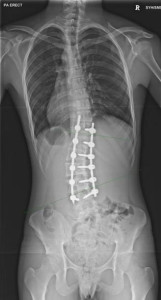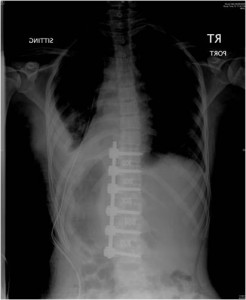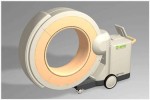Scoliosis Surgery
Surgery is a treatment option used to correct curves in the skeletally mature spine greater than 45-50 degrees or for spinal curves that haven’t responded to bracing, and progressing beyond 45-50 degrees. Surgery may also be recommended for skeletally immature patients whose curves exceed 40 degrees.
There are really two goals for scoliosis surgery: to stop a curve from worsening and to correct spinal deformity.
What Is Scoliosis Surgery?

Surgery – specifically, spinal fusion – is recommended for severe curves and for curves that have not responded to non-surgical intervention. Spinal fusion involves placing graft material between the affected bones in the spine to encourage them to fuse, or join together. The bone grafts are usually obtained from the patient’s own bone e.g. spinous processes of the vertebra, ribs, and/or pelvis. The ribs are harvested to serve two roles, one to obtain sufficient graft materials, and second to help to make the rib hump or shoulder blade prominence less. Nowadays, the spine specialist will also add external bone sources from other human donors to increase the chances of bone healing.
Instrumentation, such as screws, rods, and connectors, is implanted along the treated area. The instrumentation is key because it creates an “internal cast” to support the vertebral structures and redirect stress properly along the spine during the healing and fusing process.
Ultimately, the goal is to halt the progression of the curve and reduce spinal deformity, to the extent possible, restoring proper spinal stability and alignment.
The most common approach for scoliosis surgery is from the back or so called posterior approach (Figure 4). This approach is able to manage all types of scoliosis cases. Sometimes, another approach from the side may be needed if the scoliosis is very large, and the curves very stiff. The side approach is usually performed first, followed by the back approach. For surgeries involving the back approach, there is no need for bracing after surgery in most cases.

Sometimes, for selected C shaped scoliosis (single curve), the spine specialist may decide to approach surgically from the side, the so called anterior approach (Figure 5). Bracing may be needed for these cases after surgery for a period of 3-4 months.
In very young patients presenting with severe scoliosis, fusion should be delayed till they are more matured. Therefore, non-fusion surgery should be performed first to stop the scoliosis from progressing. Definitive spinal fusion can be performed when the child reaches teenage years and has gained reasonable height.
Examples of non-fusion surgery performed include VEPTR (vertical expandable prosthetic titanium rib), growing rod (single or two rod methods), and SHILLA procedure.
Safety in Scoliosis Surgery
Nerve and spinal cord monitoring is crucial in the maintenance of safety in scoliosis surgery. Such monitoring reduces the incidence of a poor surgical outcome by 50 to 60%. Monitoring involves putting sensors on the patient that monitor changes in their electrical signals. When performed by a trained expert, it will spot changes in brain, spinal cord and peripheral nerve function before there is any irreversible damage. Correctly performed, monitoring of nerves during the surgery can guide the surgeon through a smooth and safe surgery. The monitoring will alert him or her of a stimulated nerve. It can show nerve stress or damage and even pinpoint the location of the irritation.
Surgical Navigation

Surgical navigation allows the spine specialist to see the procedure as it is performed in real time.
The concepts behind navigation are similar to those in a Global Positioning System (GPS). It provides the surgeon image visualisation during surgery.
A popular system currently in use is the O arm (Figure 6).
PediGuard

PediGuardis a device for real-time detection of possible penetration outside the vertebral pedicle (Figure 7). The pedicle is the bony structure in the spine where the screws are anchored. Pediguard is a drilling instrument that constantly monitors the electrical conductivity of the tissue at its tip throughout the drilling process. It measures and translates the electrical conductivity into an audio and visual feedback, and allows the surgeon to know whether the tip is in contact with bone.
Learn more about the diagnosis and back brace for scoliosis and causes for scoliosis. Contact us for a comprehensive consultation at Singapore Pinnacle Spine & Scoliosis Centre today.
Looking For A Reliable Back Orthopaedic Specialist?
Fast Medical Attention, Transparent Fees
Make an appointment for comprehensive care for your back problems!
